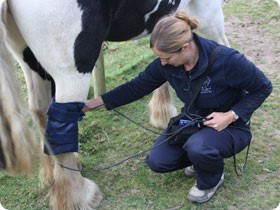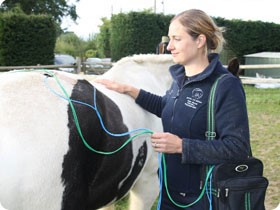Electrotherapy
Electrotherapies are a very useful adjunct to manual therapies, and can be used to increase the rate of healing or to promote a better quality repair.
Pulsed Electromagnetic Field Therapy (PEMF)

PEMF is a deep penetrating therapy. It works by affecting the cell membranes, positively affecting the passage of calcium ions. This results in an increased enzymatic activity and a biological chain reaction which reduces inflammation and increases localised bloodflow.
Improved and accelerated bone healing is highly evidenced in research with success rates of 80% noted in non-union fractures through the microelectrical currents produced stimulating osteoblast activity.
PEMF also has a relaxing, warming effect on the muscles, and is suggested prior to, or during massage and PROM and soft tissue work.
Transcutaneous Electrical Neuro Stimulation (TENS)
Post-operative and chronic pain relief can be provided through TENS, by positioning the electrical pads around the surgical or painful site. A high frequency, long pulse duration stimulus causes the pain gate to close, blocking the pain signals to the brain. The release of opiate-like substances at the site of the TENS application have wide reaching and lasting analgesic effects. TENS is indicated for chronic musculoskeletal pain, including spinal pain and neuralgia in animals.
The units are suitable for home use, and with training can be left with the owner to apply frequently, thus achieving a greater cumulative effect.
Interferential Therapy
Interferential therapy units can be set to function as neuromuscular electrostimulators, working to treat muscular disuse atrophy through re-education of the muscular function, and is indicated to counter chronic disuse atrophy.
Additionally, analgesic effects may also be achieved, but in a more comfortable way for the patient than through TENS. This is due to the higher frequency of the electrical pulse emitted, being such that it doesn't trigger the nerve endings in the skin. Interferential therapy is very effective in addressing chronic muscular spasm.
H-Wave

H-wave is waveform found naturally within the body. It has potent analgesic effects and therapeutic effects depending on the frequency of the stimulation. H-wave is used in equine rehabilitation only.
H-wave has been proven in anecdotal and small sample sized trials to increase the rate of lymphatic drainage, and is particularly useful when applied over large muscle groups in the treatment of oedema.
Effective and gentle mobilisation of the lumbosacral junction can be achieved through specific electrode placement over the middle gluteals and the lumbar region. The motor firing of the muscle produces a rhythmical rocking which aids the reduction of muscle spasm in this region, reducing pain and trigger points, and also serve to aid later rehabilitation and the quality of ridden work by encouraging the ability to lower and tilt the pelvis through transitions, and in maintenance of the gait.
Therapeutic Ultrasound

Therapeutic ultrasound is a mechanical therapy, which acts most effectively on collagenous tissues and over synovial joint capsules where the energy is more readily absorbed. The acoustic streaming of the ultrasound beam, and the stable cavitation effects produced in the tissues are of particular benefit in establishing correct alignment of new and repaired tissue fibres. Two different wavelengths are used, 3MHz for superficial tissues and longer 1MZ wave ultrasound is advocated over deeper tissues.
Phototherapy
LASER and Phototherapy provides two benefits; a local analgesic effect due to the release of endogenous opiates and serotonin, and an accelerated proliferation phase in cells which can increase tissue healing rates. The light energy is absorbed by the cell mitochondria, and the biological pathways within the cell then altered to facilitate increased ATP production and subsequently RNA / DNA synthesis. Phototherapy is particularly useful in managing wound healing.
To learn more about our equine services or to book an appointment please contact Helen Morell




